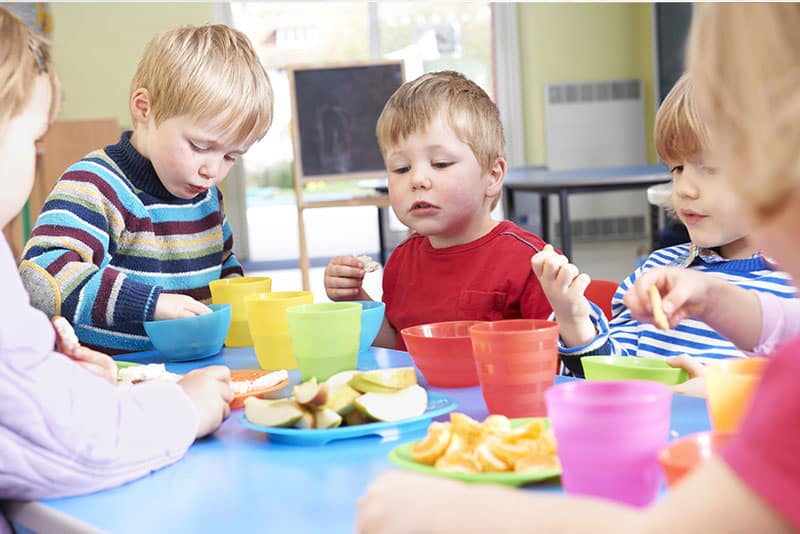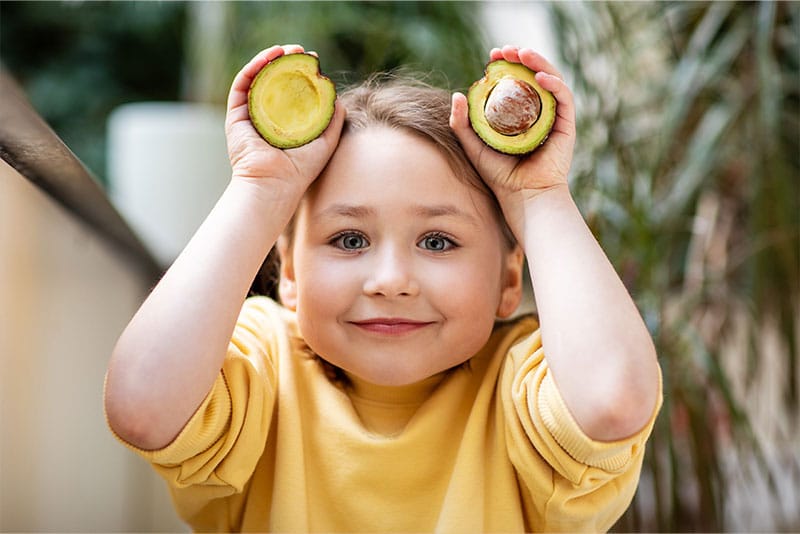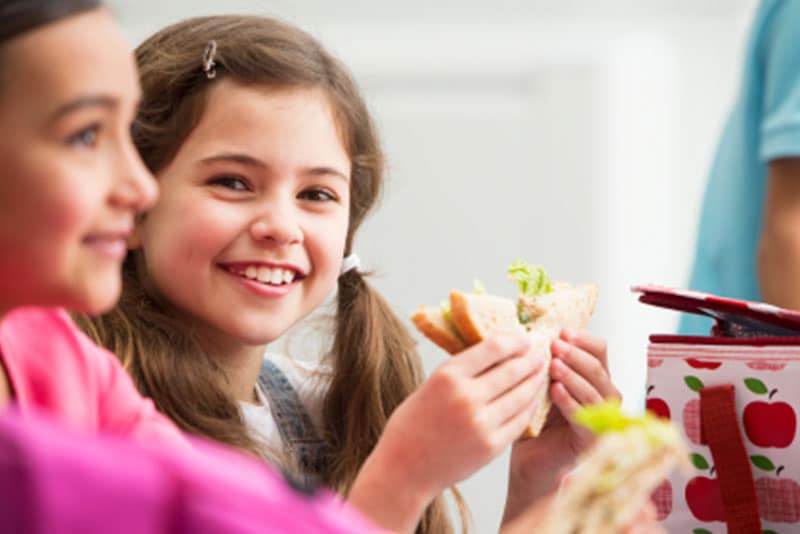Early Childcare Menu Planning Frequently Asked Questions
Got a question you want answered?

Got a childcare menu-related nutrition question?
Check out the answers to some of the frequent and important queries we receive below.
Can’t find your questions answered?
Submit your question and one of our dietitians will respond. We may publish the question and answer here and in our monthly newsletters, but we won’t include your details.
Peanuts are not a staple food, so you can avoid serving them in childcare service menus without impacting on the nutritional quality of your menu. Also, services who need to serve a food that a child is allergic to have to take special precautions to avoid contamination. If you don’t need to do this then it will make life easier.
Although the child might not have had an anaphylactic reaction so far, they may still become anaphylactic in the future. Your service doesn’t want to be the site of their first anaphylactic reaction!
So, our advice would be to avoid serving peanuts if you have a child in your service with a diagnosed peanut allergy, regardless of their symptoms.
Just like at home, the simple answer is no. Providing alternative meals to children who refuse an offered meal might solve the problem on the day, but it doesn’t solve the problem in the long term. So keep your long game in sight!
A skipped meal or two will not harm a healthy child and they will eat when they are hungry. Wait until the next scheduled meal or snack before offering something new.*
You can reduce the chances of food refusal by:
- Providing at least one food that you know the child/ren likes and introducing one new food at a time, in a small portion.
- Acknowledging children’s independence and recognising children have genuine likes and dislikes.
- Establishing routines around when and where food is eaten.
- Offering realistic amounts of food.
- Limiting the length of mealtimes (about 30 minutes maximum).
- Establishing a positive eating environment by encouraging children to touch, smell and taste new foods and textures (without any expectation of them swallowing it).
- Having a consistent approach amongst carers.
- Leading by example through carers eating the same food at the same time with children, being enthusiastic and initiating positive discussions around healthy food.
*There may be some exceptions (e.g. children with type 1 diabetes or those with sensory or developmental issues) but even in these cases it is still best to follow the guidelines above. Discuss with the parents and health professionals who care for these children how best to manage food refusal considering their special needs.
The main nutrients that foods from the dairy food group provide are protein and calcium.* Dairy foods also contain lots of other nutrients, but these two are the main ones. So if you are needing to swap out cow’s milk products, you need to find a substitute that will provide similar amounts of protein and calcium to cow’s milk.
Soy milk is naturally high in protein and contains more protein than other plant-based milks. Check that the product you are buying is also calcium** fortified.
Nut milks (e.g. almond, cashew), oat and rice milks are lower in protein than cow and soy milk. They may also be lower in other important nutrients. They are not a great replacement for cow’s milk and are suitable only when you have a child that can’t have cow’s or soy milk. If you do need to use one of these milks make sure it has been fortified with both protein and calcium**. Rice milk is not a good choice for young children as it is very low in protein.
Coconut milk is higher in saturated (unhealthy) fat than other milks. It is also low in protein and low in calcium and lower in other important nutrients. It is not a good choice for children.
So, our advice would be to use soy milk as your preferred plant milk. If soy milk is not an option, then oat and almond milks are also okay, as long as they are calcium and protein fortified. Avoid coconut and rice milks.
*Cow’s milk has around 110 mg calcium and 3–4g protein per 100ml.
**Check the calcium level on the milk package nutrition information panel. You want the milk to provide more than 100mg calcium per 100ml.
Your service needs to provide a menu that meets the nutrition guidelines as well as being acceptable to the children in your care and their families. But sometimes parents and educators may not be aware of the nutrition guidelines for menus and are confused as to why your menu offers some foods frequently (e.g. wholegrain/wholemeal breads and cereals) and others rarely or not at all (e.g. sausages or crumbed fish).
Depending on how you display your menu to families and educators, why not display a completed copy of the Caring for Children Nutrition Checklist alongside it?
If you have recently had a menu review, you could also display your report to further explain the guidelines (click on the guideline image so the guideline text prints). If you received a Central Coast Local Health District Healthy Menu Award, make sure this is well promoted too!
Milo does contain iron and is often recommended as a way to provide extra iron to those who need it.
However, Milo by itself is an occasional food. It scores 1.5 stars on the Australian Health Star Rating system. And when associated with Milo, milk goes from having a 5-star rating to 4.5 stars.
So, yes, Milo does contain iron, but there are more nutritious foods that can be used to provide additional iron for children when at childcare such as wholegrain breads and cereals, legumes and green leafy vegetables.
Yes, cow’s milk powder does provide the same nutrition as fresh milk. It has been dried out through spray drying, so only the moisture has been removed.
On our cost comparison, using the major supermarkets, powdered milk is slightly more expensive than fresh milk:
1 litre fresh milk (Dairy Farmers full fat) = $2.05* (purchased as a 2 litre bottle)
1 litre reconstituted powdered milk (Devondale full fat) = $2.36* (purchased as a 7-kilogram bag which makes 7 litres of milk)
With no name brands and using cheaper supermarkets, you might find that the powdered milk ends up being slightly cheaper than fresh milk. However, it might not be worth the extra staff time of reconstituting the powder!
Also, powdered milk can usually only be found in full-fat and skim milk. And while full fat milk is suitable for children under two years of age, those over two years of age need reduced-fat milk, which is difficult to find in powdered milk. Skim milk is too low in fat and not suitable for children.
So, while powdered milk does provide the same nutrition as fresh milk, as reduced-fat milk is not readily available and the costs are similar, it may not be worth the run around!
NSW Childcare services are exempt from National Standard 3.3.1 – Food Safety Programs for Vulnerable Persons and the NSW Vulnerable Persons Food Safety Scheme which states that unsealed wood or timber cannot be used in food preparation.
Central Coast Council Environmental Health has given us this clarification on the use of wooden spoons in childcare food preparation:
Wooden spoons are fine to use as long as they are fit for their intended use, and they are cleaned then sanitised (through a dishwasher, chemical treatment or hot water at 77+ degrees Celsius) prior to re-use.
A small amount of jam, honey, maple syrup or golden syrup is fine to use. Just remember that these toppings don’t provide any nourishment to the children. More nourishing sweet spreads and toppings for pikelets, scones and English muffins include:
- ricotta, cottage cheese or yoghurt blended with soft fruit
- mashed banana
- reduced-fat cream cheese with a dollop of fruit puree (or just spread it thinly over the cream cheese)
Egg powder is made by dehydrating the eggs using spray drying. This means that the whole egg, and most of its nutrients, are in the powder and it is just missing the water which you add back when using. There are small losses of some nutrients but not enough to cause problems.
Egg powder is convenient as it has a long shelf life and cuts down the time it takes to crack and open eggs. It can only be used in dishes where the whole egg is mixed, e.g. frittatas, scrambled eggs, omelettes and cakes.
So the answer is yes, powdered eggs are as nutritious as fresh. However, we couldn’t find anyone that was currently selling egg powder in Australia and so we couldn’t do a cost comparison between fresh and powdered. If you do find a supplier and want to trial using powdered egg, make sure you compare the cost of fresh eggs versus the cost and convenience of powdered eggs in making your decision. And let us know how you go!
Yes, we know red meat is expensive and it is tempting to buy low-quality mince (3-star/18% fat content) because it is cheaper. However, low-quality beef mince is actually providing less meat, which means you need to use more to meet the guidelines.
The current Caring for Children guidelines recommend that each child (2–5 years of age) be provided with ¾ serve of the meat & alternatives food group each day in care. This equals 70g of meat. If you are using low-quality mince you would need to use ~85g per child to give the same amount of meat.
So, we recommend buying lean beef mince (5-star or 5% fat content). Why pay for fat?
If you are making patties (burgers, rissoles or koftas) with mince, a fattier mince is often used as it keeps the meat together. But you can achieve the same thing with lean mince by adding an egg or baking the patties in the oven. If you have any other tricks for keeping patties together when using lean mince, please let us know!
Cream is occasional and is best left off childcare menus. And when we say cream, we also mean sour cream, light cream, coconut cream and the new plant creams.
Why? Well, cream is high in saturated fat and high in kilojoules and doesn’t provide a wide range of nutrients. In other words, it is “energy (kilojoule) dense and nutrient poor”.
We often see cream (in its many guises!) on childcare menus and are always thinking… ‘what can the cream be swapped with that is more nutritious?’
So, here are our top picks for more nutritious cream alternatives: evaporated milk, yoghurt, white (bechamel) sauce and pureed silken tofu (with or without milk). All of these options provide the creaminess but will also give the children extra nutrients such as protein, carbohydrate, and calcium.
We are hearing of more and more services who have children enrolled with dietary restrictions. Managing children with dietary restrictions can increase food costs and requires cooks and early childcare staff to make extra effort to keep children safe. Children on restricted diets may also miss out on important nutrients and the opportunity to explore a variety of foods.
However, it is important to keep our children safe and comfortable and we should make every effort to ensure the food we provide in childcare does this. It is also a legal requirement under the Education and Care National Regulations to ensure that food provided by a service “is chosen having regard to the dietary requirements of individual children taking into account … any specific cultural, religious or health requirements.”
But what do you do when it appears that the dietary restrictions that you are strictly following at childcare are not adhered to at home?
The first step is always communication with the family. It may help to flag with all families that you will be doing a regular dietary restriction check to find out if children’s requirements have changed. This provides an opportunity to start the conversation. Another helpful strategy is to let parents know that, in your efforts to ensure children are provided with adequate nutrition, it is a requirement for your service to have medical documentation on the need for health-related dietary restrictions.
Of course, if a child has a dietary restriction based on their culture or religion, this needs to be respected. You can still check in on a regular basis to find out if the family is wanting to continue with this requirement at childcare.
Mexican tacos are a fun way to offer a wide range of foods in one meal, especially vegetables. We recommend you serve taco fillings in a tortilla wrap instead of hard taco shells. Tortilla wraps fit in the bread and cereals food group and are available in wholegrain varieties to help provide some extra fibre. They can still be a fun way to include Mexican flavour, allowing children to add their own fillings when appropriate.
Taco shells are not recommended for inclusion on a healthy childcare menu. They are considered an occasional food because they are much higher in fat, similar to corn chips.
Other pages you might be interested in



Latest News


Advice and support on alcohol and pregnancy

